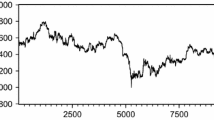Abstract
Hiemstra and Jones (1994) argued that a significant negative value of their nonlinear Granger causality test (H-J test) means there is a confounding effect in the prediction. However, from the theoretical analysis and Monte Carlo simulations, the authors find that H-J test is significantly negative under the circumstance of negative volatility spillover. Furthermore, the authors put forward the conceptions of positive/negative nonlinear spillover, and apply H-J test to examine positive/negative nonlinear spillover effect. The empirical study on China stock futures and spot markets shows that: 1) There is significant positive nonlinear spillover from futures to spot market; 2) There is significant negative nonlinear spillover from spot to futures market. The authors argue that there is “risk absorption” mechanism in information spillover from the spot market to the futures market, which is due to the temporal transfer of speculative trading from the analysis.
Similar content being viewed by others
References
Granger C, Investigating causal relations by econometric models and cross-spectral methods, Econometrica, 1969, 37: 424–438.
Sims C, Money, income and causality, American Economic Reviews, 1972, 62: 540–552.
Kawaller I, Koch P, and Koch T, The temporal price relationship between S&P500 futures and the S&P500 index, Journal of Finance, 2008, 42: 1309–1329.
Abhyankar A, Return and volatility dynamics in the FTSE 100 stock index and stock index futures markets, Journal of Futures Markets, 1995, 15: 457–488.
Lihara Y, Kato K, and Tokunaga T, Intraday return dynamics between the cash and the futures markets in Japan, Journal of Futures Markets, 1996, 16: 147–162.
Frino A and West A, The lead-lag relationship between stock index and stock index futures contracts: Further Australian evidence, Abacus, 1999, 35: 333–341.
Chiang R and Fong W, Relative informational efficiency of cash, future, and options Markets: The case of an emerging market, Journal of Banking and Finance, 2001, 25: 355–375.
Ryoo H and Smith G, The impact of stock index futures on the Korean stock market, Applied Financial Economics, 2004, 13: 245–263.
Athanasios V, Lead-lag relationship between futures market and spot market: Evidence from the Greek stock and derivative market, International Research Journal of Finance and Economics, 2010, 41: 163–176.
Granger C, Forecasting in Business and Economics, 2nd edition, Academic Press, San Diego, 1989.
Brock W, Causality, chaos, explanation and prediction in economics and finance, in Beyond Belief, Casti J, Karlqvist A, Fla.: CRC Press, Boca Ration, Fla, 1991.
Baek E and Brock W, A general test for nonlinear Granger causality: Bivariate model, Working Paper, Iowa State University of Wisconsin, Madison, 1992.
Hiemstra C and Jones J, Testing for linear and nonlinear Granger causality in the stock pricevolume relation, Journal of Finance, 1994, 49(5): 1639–1664.
Abhyankar A, Linear and non-linear Granger causality: Evidence from the FT-SE 100 stock index futures market, Journal of Futures Markets, 1998, 18(5): 519–540.
Asimakopoulos I, Ayling D, and Mahmood W, Non-linear Granger causality in the currency futures returns, Economics Letters, 2000, 68: 25–30.
Huh H, GDP growth and the composite leading index: A nonlinear causality analysis for eleven countries, Economics Letters, 2002, 77: 93–99.
Chiang T, Qiao Z, and Wong W, New evidence on the relation between return volatility and trading volume, Journal of Forecasting, 2009, 29(8): 502–515.
Wang C and Wu C, Linear and nonlinear Granger causality test of stock price-volume relation: Evidences from Chinese markets, Journal of Management Sciences, 2002, 5(4): 7–12 (in Chinese).
Fang Z, Wang C, Li Y, and Lu T, Linear and non-linear granger cause relation between stock and warrant in Chinese stock market, System Engineering, 2006, 24(7): 50–56.
Pan Y, Study on the dynamic linkage between stock markets based on non-linear granger causality test, The Journal of Quantitative and Technical Economics, 2008, 9: 87–100.
Zhou P and Li Z, Time-varying spillover between the mainland China stock market and the other global main stock markets base on the non-linear Granger causality test, Systems Engineering: Theory & Practice, 2012, 32(3): 466–475.
Denker M and Keller G, On U-statistics and von-Mises statistics for weakly dependent process, Zeitschrift für Wahrscheinlichkeitstheorie und Verwandte Gebiete, 1983, 64: 505–522.
Granger C, Testing for causality: A personal view, Journal of Economic Dynamics and Control, 1980, 2: 329–352.
Diks C, Panchenko V. A new statistic and practical guidelines for nonparametric Granger causality testing, Journal of Economic Dynamics & Control, 2006, 30: 1647–1669.
Dickey D, Fuller W, and Panchenko V, Likelihood ratio statistics for autoregressive time series with a unit root, Econometrica, 1981, 49: 1057–1072.
Phillips P and Perron P, Testing for a unit root in time series regression, Biometrika, 1988, 75: 335–346.
Akaike H, A new look at the statistical model identification, IEEE Transactions on Automatic Control, 1974, 19: 716–723.
Ljung G and Box G, On a measure of a lack of fit in time series models, Biometrika, 1978, 65(2): 297–303.
McLeod J and Li W, Diagnostic checking ARMA time series using squared-residual autocorrelations, Journal of Time Series Analysis, 1983, 4(2): 269–273.
Engle R, Autoregressive conditional heteroskedasticity with estimates of the variance of the United Kingdom inflation, Econometrica, 1982, 50: 987–1007.
Schwarz G, Estimating the dimension of a model, Annals of Statistics, 1978, 6(2): 461–464.
Copeland T, A model of asset trading under the assumption of sequential information arrival, Journal of Finance, 1976, 31: 135–155.
Jennings R, Starks L, and Fellingham J, An equilibrium model assest trading with sequential information arrival, Journal of Finance, 1981, 36: 143–161.
Author information
Authors and Affiliations
Corresponding author
Additional information
This research was supported by the National Natural Science Foundation of China under Grant Nos. 71001096, 70933003, and 71071170.
This paper was recommended for publication by Editor ZOU Guohua.
Rights and permissions
About this article
Cite this article
Zhou, P., Lu, F. & Wang, S. Testing linear and nonlinear granger causality in CSI300 futures and spot markets based on new concepts of nonlinear positive/negative spillover. J Syst Sci Complex 27, 729–742 (2014). https://doi.org/10.1007/s11424-014-2261-3
Received:
Revised:
Published:
Issue Date:
DOI: https://doi.org/10.1007/s11424-014-2261-3




